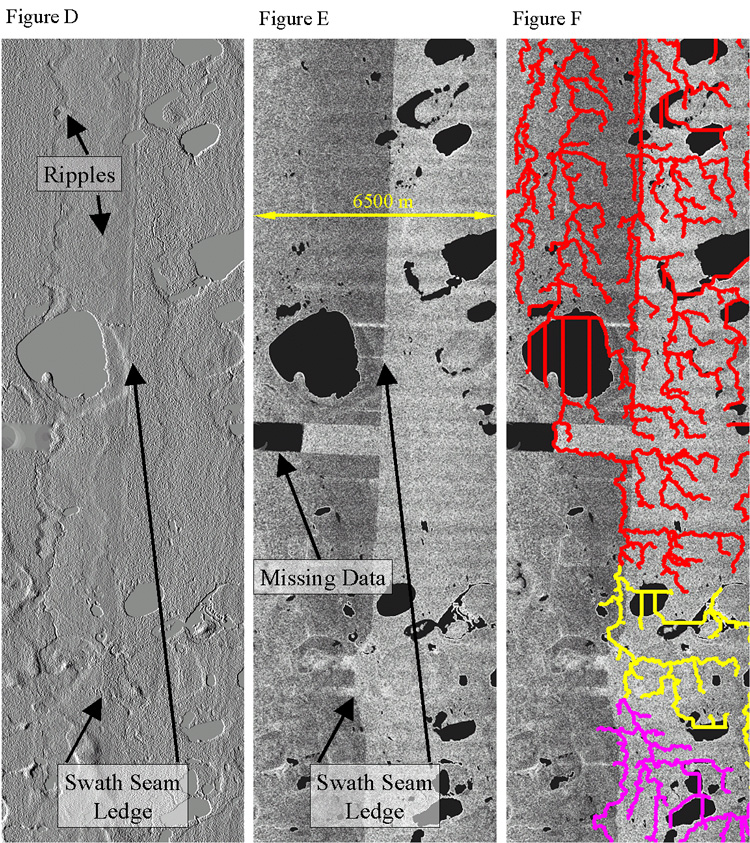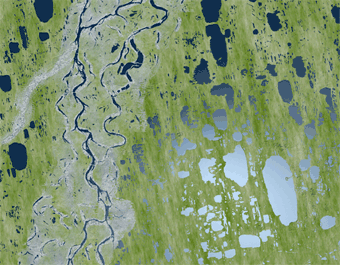Watershed-Scale
Analyses of an Arctic Drainage Using A New High Resolution Digital
Elevation Model |
Overview
We have acquired a high resolution Digital Elevation Model (DEM) of
the Putuligayuk River (Put) which is located within Alaska’s Coastal
Plain. The data was collected using Intermap Technologies’ airborne
Star3i X-Band radar system. We analyzed the data using RiverTools™
to derive watershed drainage areas and stream channels. Our findings
strongly suggest that this DEM significantly improves our ability
to analyze and understand hydrologic processes within low-gradient
Arctic watersheds.
|
 |
Star3i DEM Offers Highly
Accurate Terrain Representation - Giving us our First Clear View of
the North Slope’s Topography
The Star3i DEM features postings of 5 m with horizontal accuracy of
2.5 m RMSE and 1 cm vertical resolution with 3 m RMSE accuracy. The
best DEM data for Alaska’s North Slope USGS offers are its 15-minute
DEM where the spacing between elevations along profiles is 2 arc seconds
of latitude by 3 arc seconds of longitude (60x90 m). This DEM has
a published vertical accuracy of 15 m within a tile, though seam errors
can be significantly larger. Because the USGS data features elevation
data in integer intervals of feet and because the same elevation value
is assigned to a relatively large area, the USGS DEM fails to adequately
represent elevations in low-gradient terrains for watershed-scale
modeling.
The two images below show a level slice of both the USGS and the Star3i
DEMs for a subset of the Put watershed. Both DEMs have been resampled
to 50 m postings, which is the best representation of the USGS DEM.
The elevation range of 0 m to ~26 m is nearly identical for both data
sets. Even after resampling degrades the Star3i data by a factor of
10, it still provides much more detail than the USGS DEM. The difference
results largely from the creation process of the USGS DEM, which creates
in broad flat areas because of the low vertical resolution (1 ft)
in this low gradient area.
|
The two grayscale images above
and to the right show aspect plots of the same area, which clearly
illustrate the difference in resolutions between the DEMs. While in
the Star3i DEM only lakes and streams are identified as flat (white),
the USGS DEM represents a significant portion of the terrain as being
flat. Accurate hydrologic modeling is dependent on the ability to
identify and include subtle terrain features into the model. The Star3i
DEM provides us with a vast amount of new information about Alaska’s
North Slope.
|
Putuligayuk
Watershed Area 24% Larger Than Previously Thought
Figure A below shows the USGS DEM derived stream channels. Stream
channels which have been found falsely draining into the Put have
been colored yellow. We established the USGS DEM derived watershed
area, after correction, to be 456 km2.
Figure B shows the Star3i DEM derived stream channels. We found errors
in this DEM as well, but we were able to identify problem areas based
on the ORRI, which shows the correct drainage direction for the streams
in question. Once the problem areas were identified we then proceeded
by manually editing the DEM to route stream flow in the correct direction.
We established the Star3i DEM derived watershed area, after correction,
to be 566 km2.
The resulting watershed boundaries are shown below. USGS DEM derived
boundary is shown in blue and Star3i derived boundary is shown in
red. Using the high resolution DEM data we were able to determine
that the area for the Put watershed is by 24% larger than previously
thought. This has far reaching implications as it affects the water-
and energy-balance of this watershed.
|
  
|
Data Errors and Error Correction
We have found two sources of errors within the Star3i DEM. The first
one occurs at seam bound-aries. Because the Star3i is a side-looking
radar system the noise level on the far edge of the swath is higher
than on the near edge. When swaths are merged a near edge meets a
far edge and at times a ledge is caused by a small discontinuity.
Figure D represents a shaded relief plot of the Star3i DEM. The swath
seam ledge and some small ripples are visible. The ripples are due
to aberrations and multi-path error within the radome.
Figures E and F show a slope representation of the Star3i DEM. Figure
F illustrates that the swath seam indeed affects the stream channel
routing. In the image shown the vertical displacement caused by the
swath seam ledge is approaching 1 m and that by the ripples is <20
cm.
When deriving stream channels special attention needs to be paid to
these problem areas so that potential misrouting of stream channels
can be identified and corrected for. Intermap has recently agreed
to investigate and possibly reprocess the data to eliminate the errors
shown.
|

|
Star3i Offers new Possibilities
for Studying Thaw Lake Dynamics
Lake boundaries as well as their dimensions and orientation can be
quantitatively analyzed using the Star3i DEM. The lower left image
shows a CIR aerial photo taken in 1983 and the green outlines are
lake boundaries derived from zero-slope areas of the Star3i DEM. The
slight offset is due to the fact that the aerial image has not been
orthorectified. Using the DEM and the ORRI, however, historic aerial
imagery can now be easily orthorectified. The ability to accurately
map lake boundaries will greatly aid the estimation of lake shore
evolution over large areas with unprecedented accuracy. Using Landsat
for example, many smaller lakes go unnoticed as they occupy less area
than one pixel within one scene. With the 2.5 m ORRI nearly all of
those small lakes and ponds are mapped, and their elevation can be
determined from the DEM.
The lower right image uses synthetic textures was produced to simulate
the tundra vegetation cover and highlight the large number of lakes
using sun glint. We use such visualizations in scientific and public
outreach.
|
 
|
The Betty Pingo
Betty Pingo is one of the most prominent pingos on the North Slope.
The high spatial resolution and vertical accuracy of the Star3i DEM
allows us to precisely map the location and dimensions of pingos.
Figure G shows a slope map with Betty Pingo close to the center, figure
H shows the same area in shaded relief. Figures I and J show a 3D
view of Betty Pingo. Please note the astonishing level of detail in
the image, all of that detail is DEM derived, none has been added
by the visualization application. The texture in the images has been
synthetically created to simulate the ground cover in that area.
|
 |